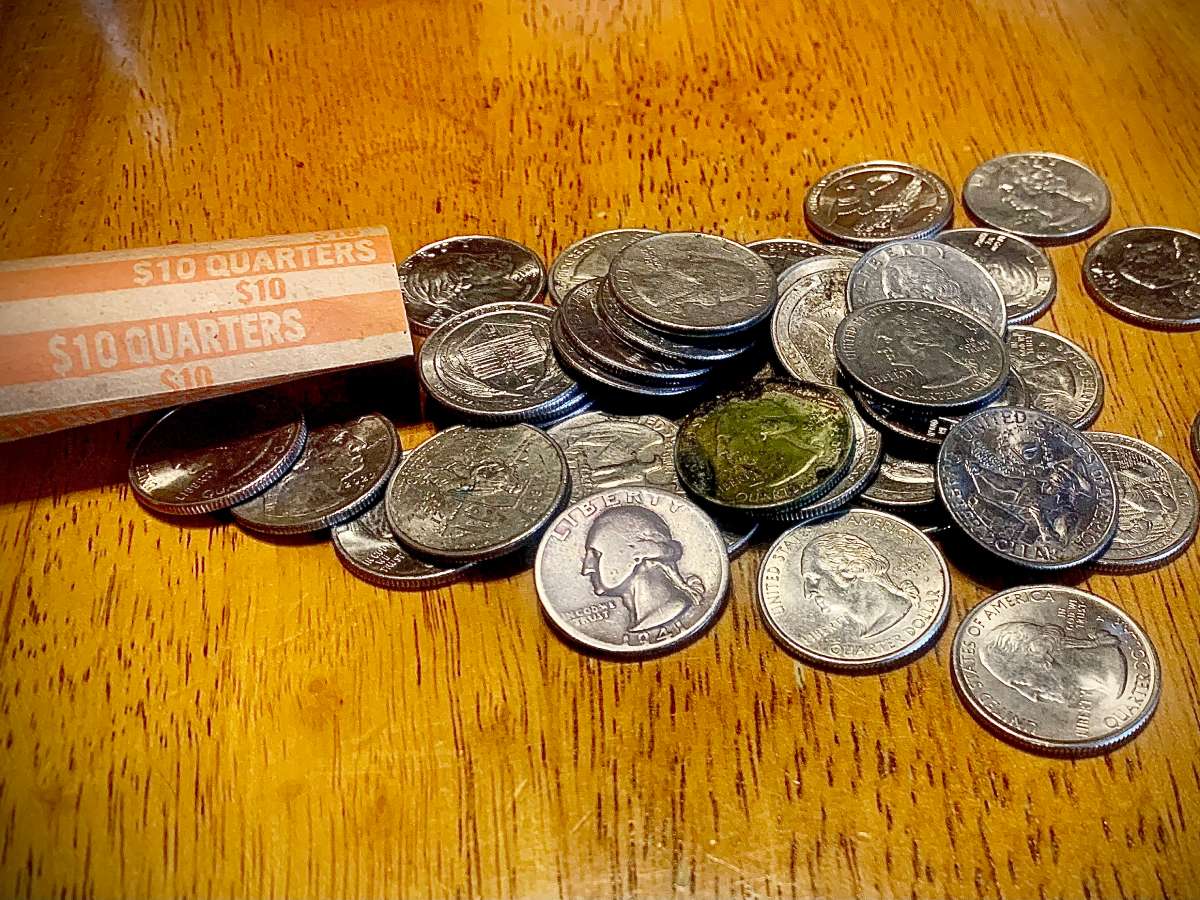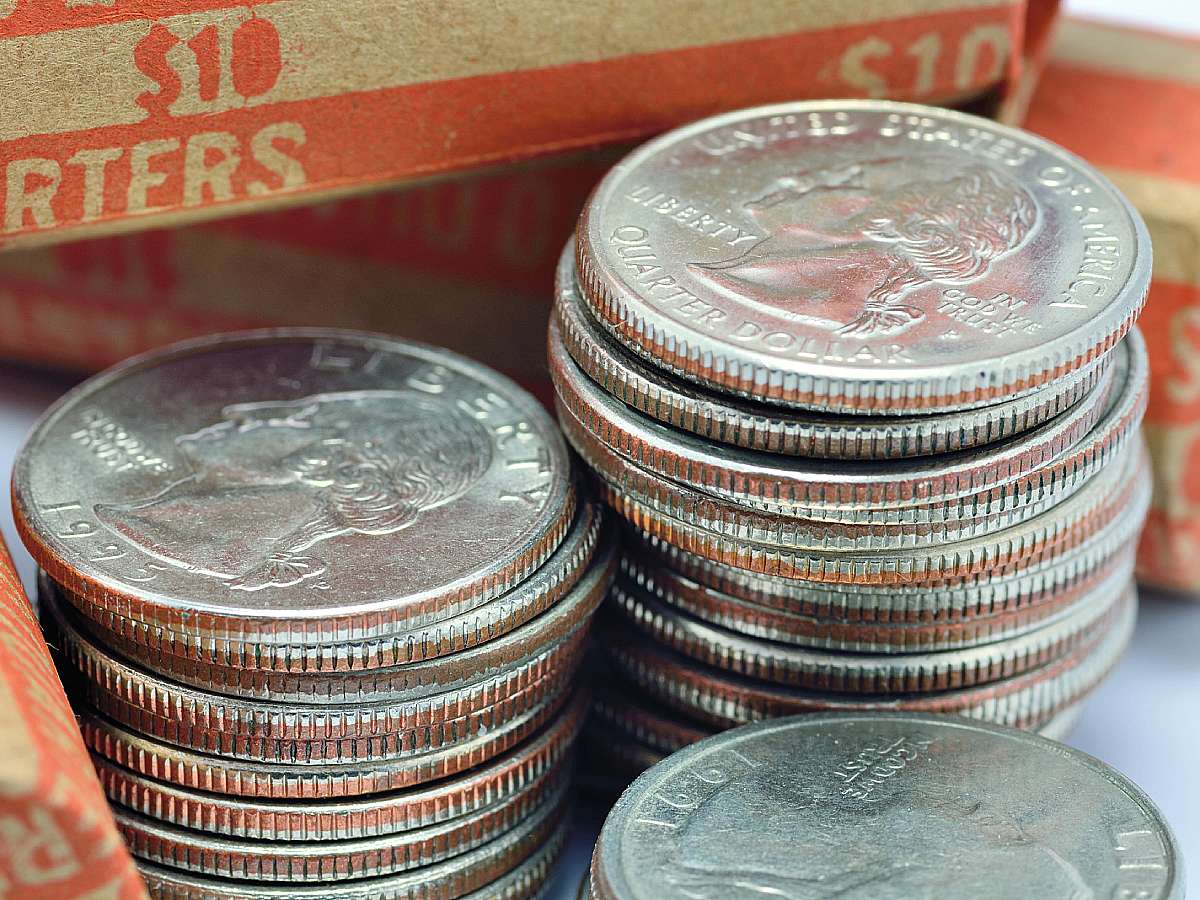Searching Quarter Rolls
There are all kinds of rare and valuable quarters out there in circulation. And you can sometimes find them in quarter rolls!
I love searching through rolls of quarters — because it’s challenging AND thrilling at the same time.

You might be surprised what some of the quarters you find in rolls could be worth.
Some are legitimately worth thousands of dollars (no hype, no kidding — you’ll see the ones I’m talking about in a minute). Other old quarters in rolls are worth only a few bucks, but that’s still better than face value!
Here’s where to buy quarter coin rolls for quarter roll hunting.
Want to know what I look for when I’m searching quarter rolls?
I’m so excited to share this list of the 8 types of valuable quarters you can find in coin rolls today AND how much these quarters are worth!…
List Of Valuable Quarters For Coin Roll Hunters
Pre-1965 Quarters
First things first, I want you to keep your eye out for any quarters dated BEFORE 1965.
What makes the year 1965 so special?
That was when the United States Mint switched from making quarters from a 90% silver alloy to copper-nickel clad.
That means all pre-1965 quarters are made from silver.
So, be sure to keep your eyes peeled for 1964 quarters. And certainly all pre-1964 quarters, too.
1965 Silver Quarter Error
There’s an incredibly rare and valuable 1965 quarter error that you could actually find in a roll of quarters today. It’s the 1965 silver quarter.
And when I say this one is worth big bucks, it’s no joke. The 1965 quarter error value is $7,000 — on the low end!
Several collectors have found 1965 silver quarters in recent years, making this rare silver quarter error something that you actually have a realistic, if tiny, chance of finding.

How To Find The 1965 Silver Quarter In Rolls
The first thing you need to do when searching quarter rolls for silver is to start holding aside any and all 1965 quarters you find.
The next thing is to get out your coin scale and a coin magnifier. You’re going to need these to start sorting the clad 1965 quarters from the ones that might be silver.
You want to look for any 1965 quarters that don’t have an orange or brown stripe around the edge of the coin. That darker stripe is the copper in the clad coin. So, a 1965 quarter that doesn’t show evidence of that edge stripe may, in fact, be a silver quarter. Using a coin loupe (a type of magnifier) can help you better see the presence or absence of this orange or brown ring around your 1965 quarter.
But don’t rely on the visual diagnostic alone. You absolutely MUST weigh your 1965 quarters to further verify if they’re clad or silver.
Here are the 1965 quarter weights:
- 1965 clad quarter weight — 5.67 grams
- 1965 silver quarter weight — 6.25 grams
Just bear in mind that not all clad or silver quarters weigh exactly those amounts. Tolerances are allowed — which means:
- A clad quarter could weigh .227 grams more or less than the 5.67 gram standard weight. Therefore, a 1965 clad quarter could weigh as little as 5.44 grams or as much as 5.90 grams.
- The tolerances for a silver quarter are .194 grams more or less. Thus, a 1965 silver quarter could weigh between approximately 6.06 grams on the low side and 6.44 grams on the high side.
All of these fractional weights we’re dealing with here illustrate why you want your coin scale to provide readouts to at least the tenth of a gram and, ideally, a hundredth of a gram. This ensures rounding won’t give you false positives or negatives when weighing potential 1965 silver quarter errors.
And that, my friends, is how to spot silver coins from a quarter roll!
1977-D Silver Quarter Error
The U.S. Mint struck millions of 1976 Bicentennial quarters in a 40% silver format for collectors. But apparently some of the 40% silver blanks ended up getting struck by 1977-dated quarter dies bearing the D mintmark of the Denver Mint.
A few of these transitional 1977 silver quarter errors are known, and they are absolutely worth a lot of money. The 1977-D silver quarter error is worth nearly $5,000.
So how do you know if you have one of these rare 1977 quarter errors worth money?
First, you’ll need to weigh it. The 1977 silver quarter will weigh around 5.75 grams.
I can already hear you asking me this question: “Isn’t that within weight tolerances of the 1977 clad quarter?”
Yes, it is. So, another thing you can do to determine whether you have a 1977 silver quarter error is to check the edge. The 1977 silver quarter will have a greyish ring around it — lighter in color than the orange to brown edge that’s more characteristic of the copper-nickel clad coins.
Finally, if you’re still unsure whether yours is a 1977 silver quarter or not, it may be best to submit your 1977 quarter to a coin grading service so they can accurately determine what you have.
1982 And 1983 Quarters
Believe it or not, 1982 quarters and 1983 quarters are conditionally scarce.
What does this mean?
Even though hundreds of millions were minted, not many were saved in uncirculated grades. How come?
For starters, there were no official U.S. Mint uncirculated sets produced in 1982 or 1983. What’s more, a severe economic recession at the time led very few people to save rolls or bag quantities of these coins.
As a result, 1982 and 1983 Washington quarters are routinely worth $3 to $5 or more in any uncirculated grades.
The 1983-P quarter is particularly scarce — even very lightly worn examples trade for $2 to $3. A 1983-P quarter in MS-65 can go for over $40.
2004-D Wisconsin Extra Leaf Quarter Error
There’s a funky error on some 2004-D Wisconsin quarters involving the appearance of an artifact alongside the ear of corn that resembles an extra leaf.
This error comes in two iterations:
- The 2004-D Extra Leaf High quarter error — This one shows the extra leaf springing up high under the main left leaf. It is worth around $150.
- The 2004-D Extra Leaf Low quarter error — The extra leaf arcs low toward the top of the wheel of cheese on this quarter. It has a value of approximately $125.
2005-P Minnesota Quarter Extra Tree Error
There are MANY different kinds of doubled die errors on the 2005-P Minnesota quarters!
So many that I can’t effectively list them all here in this rundown of valuable quarters to look for when roll searching.
Suffice it to say the bulk of these 2005-P Minnesota quarter doubled die errors contain what looks like an extra ghost tree among the spruces a few trees to the right of Minnesota’s state outline.
Most of these 2005 Minnesota Quarter Extra Tree errors are worth at least $5 to $10 — and, in some cases, much more.
2009 District Of Columbia Quarter Error
There’s a really cool 2009 District of Columbia doubled die error I’ve been looking for and still can’t find. Maybe you will? Let me tell you about it…
See the back of the 2009 DC quarter? It has a portrait of jazz legend Duke Ellington at his piano. On a handful of these quarters, there is some drastic doubling visible around the middle of the coin.
The 2009 District of Columbia quarter doubled die error shows extreme doubling of:
- The letters “ELL” in Duke Ellington’s name
- Some of the piano keys
- The panel below the keys
Values start at around $50 to $75 for circulated versions of this 2009 quarter error. But examples grading MS-65 or better easily top $1,000.
Okay, now that you know WHAT to look for, let’s talk about how difficult or easy it is to find these valuable quarters in coin rolls and how to increase your odds of finding them.
My 4 Best Tips For Searching Quarter Rolls

Listen up! Searching through rolls of coins for rare and valuable quarters isn’t going to be easy.
Let’s face it, you’ve got a lot of competition out there. Almost everybody who’s doing quarter roll hunting wants to strike it rich.
But I’ve got some tips that might help give you an advantage:
- Buy boxes of quarter rolls.
While I often pick up a roll or two rolls of quarters at a time when I’m at the grocery store or what not, buying an entire BOX of quarter rolls is far more efficient.
A box of quarters contains 50 rolls and costs $500 — so you can see why few people look through quarter rolls by the box!
That’s why, if you can afford it, it would be to your benefit to search through boxes of quarter rolls instead of just singular rolls of quarters.
And at 40 coins per quarter roll, that’s 2,000 quarters per box!
- Devise a system for sorting your finds.
I always have the above list of valuable quarters worth looking for in my head whenever I’m searching quarter rolls.
This compels me to create at least 4 little piles:
- Quarters from 1964 and earlier
- All 1965 quarters
- Post-1965 quarters matching the dates in the above list (1977, 1982, 1983, 2004, 2005, 2009)
- Any quarters that look unusual (weird strikes, odd color, etc.)
After I re-roll the quarters that I don’t want to keep (which I either spend as money OR use them to buy some more quarter rolls), I re-inspect the coins in those 4 piles.
- Go in with a game plan.
I always know what I’m looking for when I search quarter rolls. But I’m just too busy to spend 5 minutes or more looking at every little detail on each quarter in the roll.
Since I’m only interested in the most valuable quarters and I know what they are (see list above), I tend to focus only on the dates — or date ranges — that I spelled out here.
You, on the other hand, might have more time than I do. In which case, you might want to look closely at each and every coin for minor varieties and errors. And that’s cool, too! (I’ve listed the major errors and varieties above.)
- Don’t give up.
As cliche as this may sound, it’s true.
I feel like a lot of people who try quarter roll hunting throw in the towel if they don’t find anything valuable after the first roll or two. Oftentimes, they’re disillusioned because they aren’t finding many quarters worth money in rolls like that guy in a viral video they saw on social media said they could.
The most successful quarter roll searchers do what they do NOT for hours — but rather over many months and years. Stick with it!
Searching quarter rolls isn’t really a viable get-rich-quick idea. Nor is quarter roll hunting supposed to be your retirement plan… or the way you’re going to send your kids to college. Quarter roll searching should be viewed simply as a fun hobby that, if you’re lucky and persistent, could occasionally yield some exciting and valuable surprises!

Ready to try quarter roll hunting… but still have a few questions? You can always drop a line here in the comments below.
Find an interesting quarter while searching quarter rolls recently? Post a picture of your coin in the comments below and I’ll try to help.
Best of luck on your quarter roll hunting adventures. I hope you come across some great finds!




